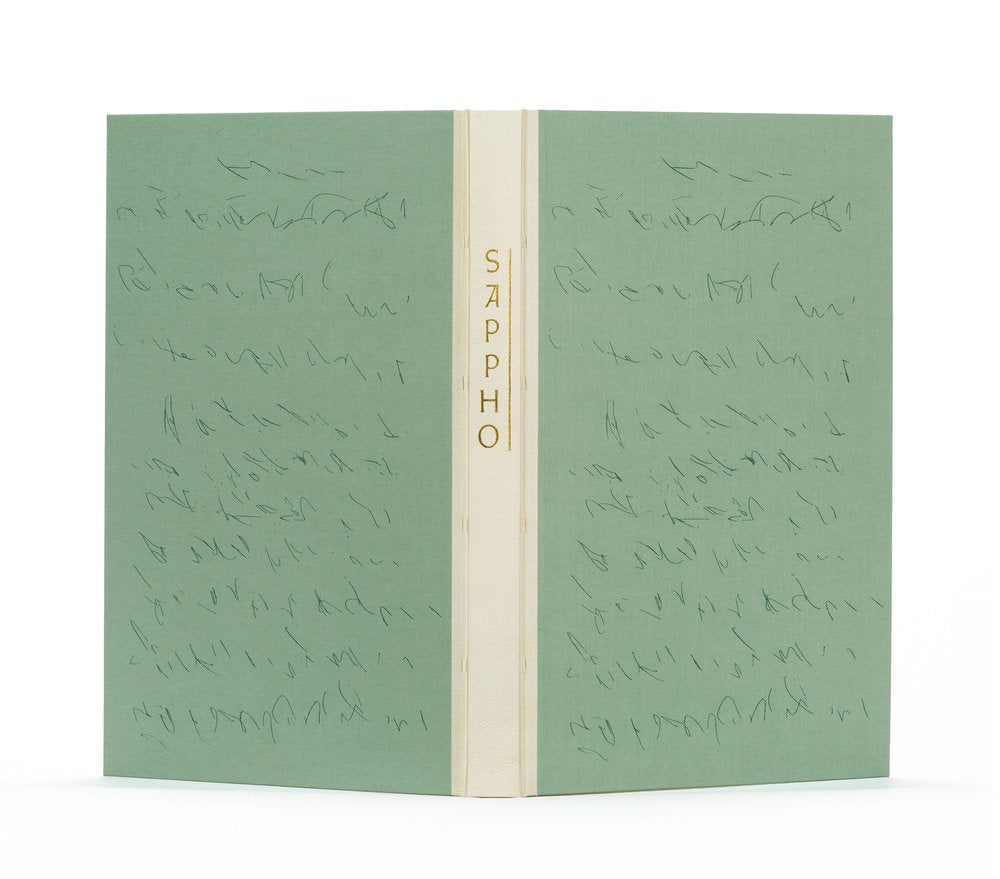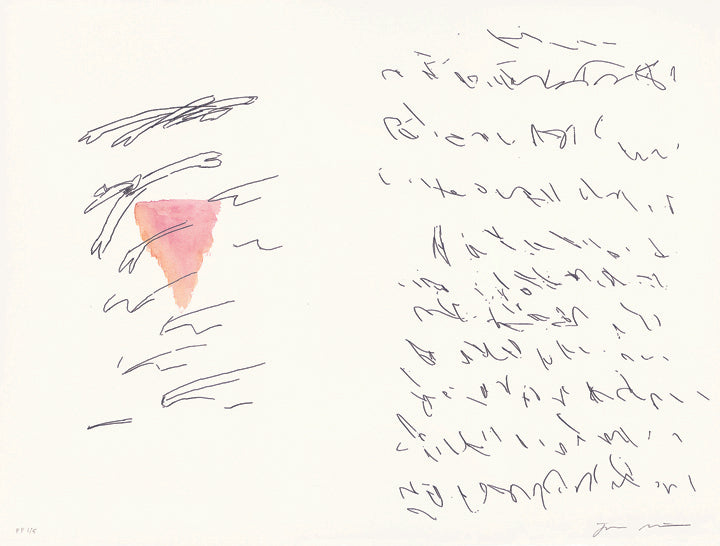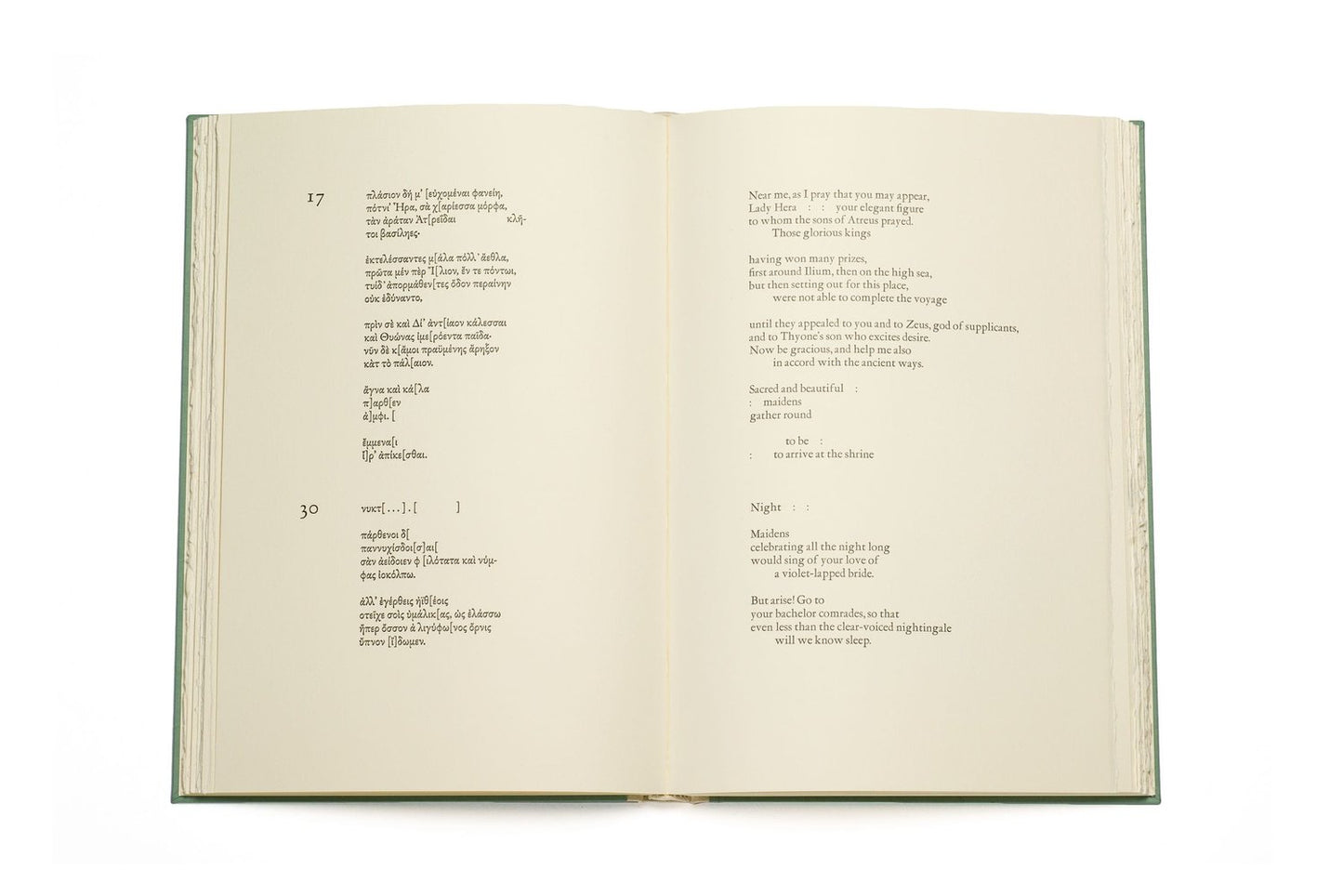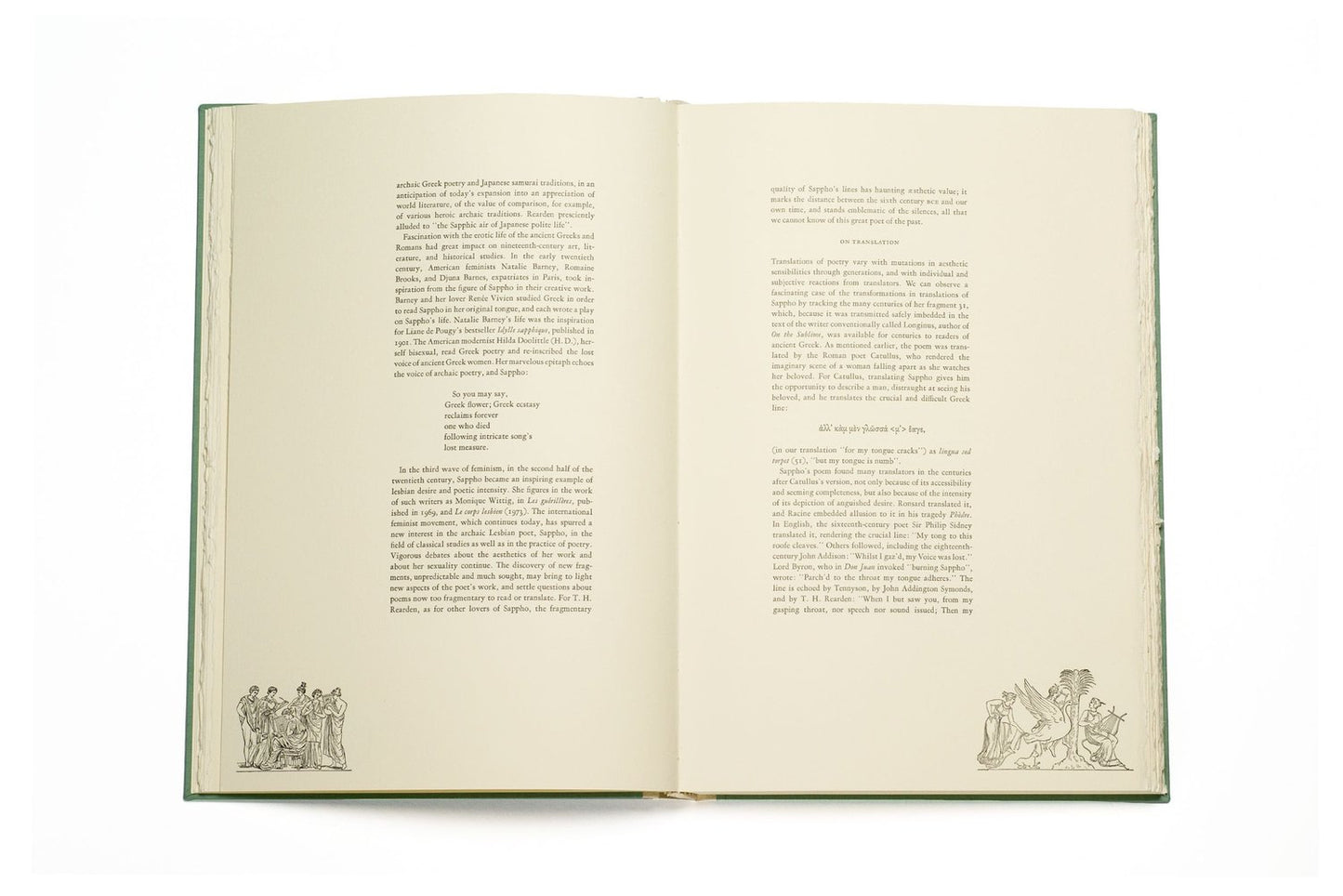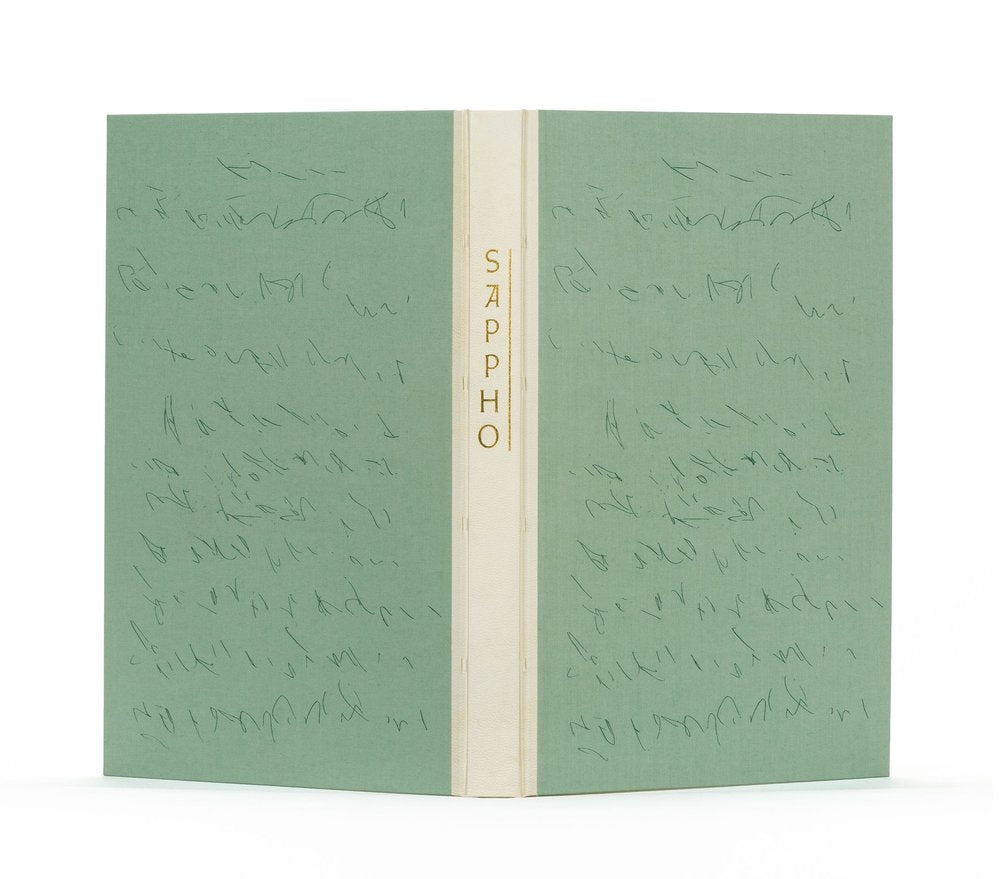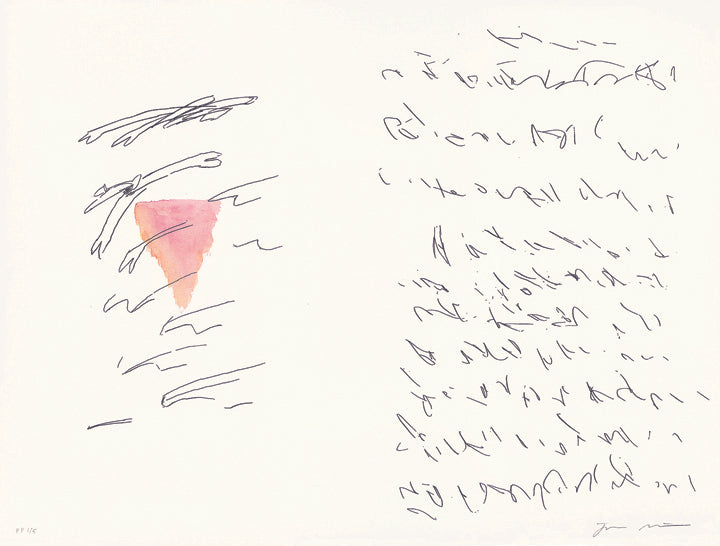Poetry of Sappho
Poetry of Sappho
In Greek with new English translation by John Daley with Page duBois, interspersed with twenty prints by Julie Mehretu, signed, November 2011. $1,750.00
Publication 93
ADD TO CARTIn Poetry of Sappho painter Julie Mehretu has created prints for her first artist book, one of Arion’s most beautiful and ambitious publications. Twenty prints by Mehretu alternate with pages of poetry in Greek and in English. Four additional prints with hand coloring are presented in portfolio. The new English translations were commissioned for this edition from poet John Daley and classicist Page duBois.
Sappho is the supreme lyric poet of antiquity. Celebrated by Plato as the “Tenth Muse”, she left a literary monument comparable to the other precious ruins of the ancient world. As with its time scarred architecture, mutilated statues, and partial inscriptions, what remains of her poems are fragments of a vanished whole, and all the more resonant for being so. The only woman whose poetry has come down to us from antiquity, Sappho wrote more than two and a half millennia ago, a century after Homer, but before the great age of Greek drama and philosophy. Her subject is not war and the state, but individual emotion and the enjoyment of beauty, expressed in unforgettable images. The theme of lost civilizations implicit in Sappho made the ancient Greek poet a fruitful subject for Mehretu.
ILLUSTRATIONS
Julie Mehretu is one of the most admired artists working today. An Ethiopian-American painter known for her densely-layered abstract images, she lives in New York City and works there and in Berlin. She received the 2005 MacArthur Fellowship.
Julie Mehretu has made twenty double-page prints for the book, to be viewed between the facing pages of Greek texts and English translations, alternating throughout. The printmaking process began with the artist scratching the emulsion side of negative film with an etching needle. Light passing through the lines allowed the negative to serve as the direct matrix for a polymer platemaker. The plate, of thin steel, with raised plastic areas for the image, was then mounted on a magnetic base, making the printing surface the same height as type for letterpress printing. The linear effect is that of an etching, though the print is relief, not intaglio. The artist used different gauges of etching needles so that the line width varies and a layering effect is created. For some images, Mehretu drew with pen and ink on mylar over proofs of the images created with the scratched negatives to add yet another layer with a different linear quality, drawn rather than scratched. These elements are heavier yet and seem to rise above the surface of the etching-like imagery.
Mehretu is interested in lost cultures, in the remnants of artifacts of earlier civilizations. Plans of settlements and architecture underlie the surface of her works. Here she seems to unearth fragmentary manuscripts, and the marks are often quite calligraphic. They are poetic statements, graphic expressions of an ancient undecipherable literature that expresses human concerns as relevant today as they were in Greece over two thousand years ago. Mehretu’s art reminds one of Kandinsky’s abstractions and their enduring appeal over a century.
In addition to the prints in the book, Julie Mehretu has made four additional prints, images not in the book, that are offered as an extra suite in a portfolio. Three of the four have been hand colored. These prints are somewhat larger and on heavier paper than that used in the book and are individually signed and numbered, suitable for framing. The suite of prints is more limited than the edition of the book. Ten percent of the book edition is accompanied by the portfolio.
The binding has a portion of an image from one of the Mehretu extra prints on the front and back covers that looks like shorthand writing or hieroglyphics.
NEW TRANSLATION
Page duBois is Distinguished Professor of Classics and Comparative Literature at the University of California, San Diego. She is the author of Sappho Is Burning, Out of Athens: New Ancient Greeks (Harvard University Press, 2010), and Sowing the Body: Psychoanalysis and the Representation of Women in Antiquity and Many Gods: The Persistence of Polytheism.
John Daley is a widely published poet and the author of the collection Not Guilty (2005). A trial lawyer in Southern California, he specializes in the defense of prisoners facing the death penalty.
When Andrew Hoyem contacted the eminent classicist Stephen Glass at Pitzer College to ask for the name of a Sappho expert, he recommended fellow classicist Page duBois, who agreed to write an introduction. In conversations with her husband John Daley, Hoyem learned of their shared interest in certain contemporary American poets, particularly Robert Creeley, Charles Olson, and Robert Duncan. Hoyem then proposed that Daley and duBois make new translations of poems and fragments that they would select, drawing on their respective skills as poet and Greek scholar.
The author reexamines the legends attached to Sappho’s life, such as her being a prostitute, a teacher of girls, a political exile, a suicide, a victim of mistaken identity (the “two Sappho” theory), establishing what contemporary historians believe to be the biography. Professor duBois explains the factors that made the unthinkable possible – for a literary legacy revered throughout the Hellenistic and Roman worlds to have almost perished by the end of the Middle Ages. She retells the chapters in the drama of its partial recovery, through translations in the Renaissance, and, in the twentieth century, from a new harvest of fragments on papyri in Egypt, preserved in a drier climate than the author’s native island culture. In taking up the most recent of these, the astonishing 2004 discovery of the “Cologne” papyri, accidentally found while unrolling the wrappings of a mummy in a German archive, duBois considers the changed meanings of the now fuller version of one of Sappho’s most wrenching verses, fragment 58, with its white-haired narrator lamenting the onset of age and the loss of beauty, yet posing, some say, the possibility of consolation. Now that more of this crucial Sappho poem is available to us, new translations are required. Daley and duBois’s translation is an important contribution, providing an artistic and scholarly rendition of the expanded poem.
FORMAT
The format is 14-1/2 x 9-3/4 inches, 112 pages. The introduction was set in 12-point Garamont Monotype. The English translations were handset in 18-point Garamont. Garamont is a type by the prolific American designer Frederic W. Goudy, based on the sixteenth-century Garamond rendered in the later style of Jannon and more recent French versions. The Greek was composed on computer in digital Adobe Garamond Greek type, printed from polymer plates. The book contains 20 double-page Mehretu prints in black and white printed from polymer plates. On the title page, introduction, and colophon are 23 wood engravings cut by Anita Cowles Rearden in the 1880s, intended as illustrations for a book on Sappho and Alcaeus by her husband Judge Timothy Rearden, now printed for the first time (at the time the book went unpublished due to the author’s unexpected death). All printing is by letterpress. The paper is Revere, an Italian mould-made sheet. The sections are handsewn with linen thread over vellum tapes, that are laced through the joints of the spine, which is also of vellum, stamped in gold with the poet’s name. The boards are covered with a fine binding cloth manufactured in Germany, of a light green color, imprinted with a portion of an image from the extra suite of prints in darker green. The book is presented in a cloth and paper covered slipcase with spine stamping similar to the book’s. The edition is limited to 400 numbered copies for sale. All copies are signed by the artist.
Portfolio Edition: In addition to the prints in the book, Julie Mehretu has made four additional prints, images not in the book, that are offered as an extra suite in a portfolio. Three of the four have been hand colored. The suite of prints by Julie Mehretu is entitled Sapphic Strophes. The individual prints are titled Sapphic Strophe 1 through 4, in a printed statement of limitation on the back of each print. The prints are relief, printed by letterpress from polymer plates, all four from negatives scratched by the artist with an etching needle, two with overlay plates made from negatives of scans of ink drawings on Mylar. The paper is Italian mould-made Revere, 15 x 20 inches. The prints are signed by the artist and numbered 1/40 through 40/40 for sale, sold only with a copy of the book, $11,750 total. Click here to order the Portfolio Edition.
POSTAGE: Additional postage may apply; please inquire for details.
Share
